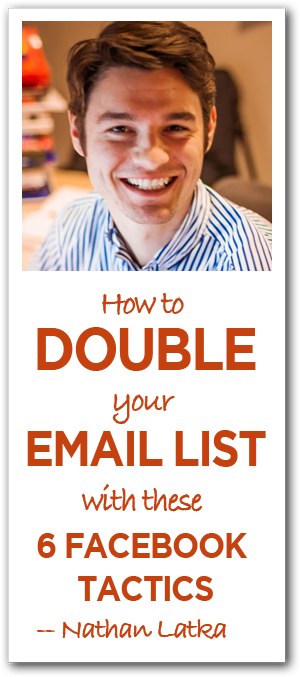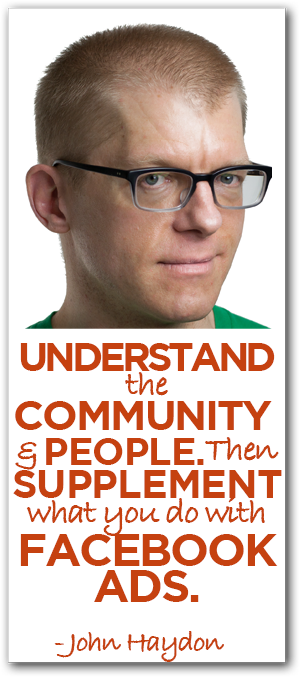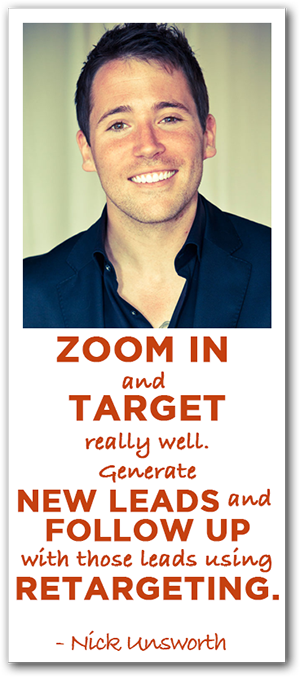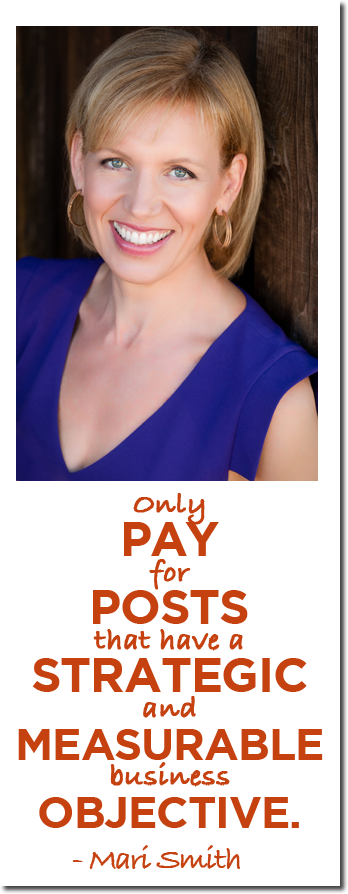 Do you have an unused or outdated Facebook page for your small business? Have you had trouble keeping your audience as Facebook continually changes its algorithms? Does your marketing plan include room for Facebook ads?
Do you have an unused or outdated Facebook page for your small business? Have you had trouble keeping your audience as Facebook continually changes its algorithms? Does your marketing plan include room for Facebook ads?
If not, then you’re not alone. A lot of small businesses don’t think their Facebook page is worth maintaining or not worth an additional ad budget. By using a well-rounded marketing strategy with consideration for organic search, paid promotion, and some creative techniques, you can optimize your Facebook page for growth once again.
This week, we bring in Mari Smith, social media leader and Facebook marketing expert, to talk about how we can tune-up our Facebook page to get the results we want.
Podcast: Play in new window | Download
Subscribe:
Big Ideas:
How did you first discover Facebook and what drew you to it?
- I’m very blessed to be a natural networker. I have a very outgoing personality and I was always a pretty networked person in the offline world.
- Back in mid-2000s I got invited to be on the beta test team of a Facebook app and I had barely heard of Facebook in early 2007. I’m very techy. I love people and I love technology. Those are my two passions. I had been somewhat active on LinkedIn, Rise, Ecademy, Plaxo, etc.
- Also Myspace…I always thought it wasn’t for business – it was for kids and musicians and so I was a little bit of a holdout.
- I thought, Facebook, not another online social network, so I was a little resistant, but it was an absolute defining moment in my life. I agreed to be on this test team of the app, and it was called PodClass – it was an education app.
- I pulled up facebook.com and time stood still for a moment. I love the layout and format and the ease with which I could find people I had long admired – influencers, authors, speakers, and leaders – and with a click of a button we’re friends and we’re chit chatting…no middle man, no secretary, no virtual assistant, anything like that.
- Before long I became a raving evangelist for the platform. I don’t work for the company, but I absolutely love it. I have an admiration for Mark Zuckerberg and his vision to make the world more open and connected, and in a short period of time I was raving to everyone about Facebook.
There’s been a lot of discussion around how difficult it is to get organic traction on Facebook. What do you say to small businesses that think it’s no longer worth it to be on Facebook?
- The bottom line is you absolutely have to change your strategy. What used to work 6 months ago no longer works, that’s clear and obvious. So, we have to stop tearing our hair out and getting angry at Mark Zuckerberg, and the whole company, and just accept it is what it is.
- We had a wonderful free ride for many many years and now the problem is where the companies that have built a Facebook audience and have come to rely on their audience on “rented land.”
- You’ve got think about “where can I build this audience on my own land?” – that would be your email subscriber list, your blog subscribers, migrating people over to your site and platform but still engaging with them on Facebook when you can but being very strategic about making offers and lead generation from Facebook.
- There are several things here with the drop in organic reach – and I’ll say as a side note, my organic reach per post went from 50,000 on average in late 2013 to now in April 2014, I’m lucky if I can get 3,000 – I’m in the same boat.
- I have this relationship with Facebook and a love for people and technology and I really study human behavior and psychology. I think how to present information in a way that’s very personable and not markety or salesy, so often I can get an organic reach from 8,000-15,000 people per post.
- So, it’s still possible to get some organic reach. The other thing is that we do have to set aside a nominal budget to pay for some promotion and get more amplification for people to see our content.
- DO NOT abandon your Facebook efforts.
- I tell people the main reason to be active on Google+ is because Google owns search. The same reason applies for Facebook.
- A main reason to have an active Facebook page with content engagement and conversion is that Facebook is the 2nd most trafficked website in the world. All that content on your Facebook page is good for Google SEO.
- Another reason is that it’s the number one social network with 2 billion active users. You can’t walk away from an audience that big. You only need a teeny teeny wee percentage of them to respond to your content to get decent ROI.
So, you need to stay there because that’s a way to feed your email list and it’s something you own, unlike Facebook which is like a networking event. Does that summarize what you’re saying?
- Yes, and want to recommend that people stay away from that boost post button – it’s absolutely ubiquitous and it’s in your face wanting you to spend money. My friend John Limmer, said “the boost button is the ‘crack’ of Facebook.” You spend $5, $10, $50, and you see those numbers go up.
- Be careful of accumulating vanity metrics – getting more likes. Unless your converting them into leads, getting them onto your email list which you own and can nurture, unless you’ve got that in place, you’re just building likes for the sake of it. Same with the engagement numbers – like PTAT.
- PTAT doesn’t pay the bills!
- The bottom line is with paying with post, you use the Facebook ads manager, or even better, the Power Editor. You can get much more granular targeting and placement so you can choose to place your promoted post on the mobile or desktop news feed. 75% of Facebook users are looking at it on your mobile device.
- The other thing is that you don’t want to just pay to promote a piece of content for the sake of promoting it or getting more eyeballs.
- Only pay for posts that have a strategic, measurable business objective behind it.
- Once a quarter, I do a launch. I launch a free webinar and then I sell an online course and that’s my bread and butter income. So, I pay for promoted posts during the time I’m offering the webinar and course – so a few weeks out of a couple months – otherwise I’m just posting regular every day content by adding value and engaging.
What are some of the best practices to set up or maybe optimize a page that hasn’t gotten a lot of love and attention? Where do you start?
- I really recommend that small businesses have an integrated marketing plan that includes their other channels, so Facebook won’t be the only one, so you’re probably growing out a profile on Twitter, Instagram, and Google+ especially for local businesses because that’s where people find you with the place page on Google.
- The good news is that it’s not that difficult to have a really good content strategy where it’s a blend of original creative content and curated content and there’s many different apps to cherry pick and pick out the best content and share that.
- I use HootSuite every day for scheduling tweets. I use Facebook’s own scheduler for posts.
- I think the key here is consistency. Small businesses optimizing their Facebook page – commit to one good post a day. Make sure you have someone on your team that’s dedicated to watching for engagement and resounding to comments as promptly as possible. Responding to reviews if you have a place page, a local business, you can respond to positive and negative reviews.
- Take a three-pronged approach to conversion strategy – content, engagement, and conversion. You get those three components in place and apply it to your social networks.
- Do what you can in the time you’ve allotted. Don’t get overwhelmed and stop before you start!
So, now when someone leaves a review on your business page, you now have the opportunity to respond to that review specifically?
- Yeah. Just the page owner though. You can’t have a conversation with other fans.
Are custom tabs still relevant for small business and if so how?
- This is a tricky one because there’s a brand new page design rolling out. It’s very much in keeping with the profiles. It’s a wider single column on the right hand side. The apps have turned into tabs, so you can only have one next to your photo. The rest are shoved way down beneath or even below the fold based on the size of your monitor.
- As a consumer I rarely click on tabs, but I love to see creative uses of them for two things – one would be promoting other social channels like Twitter, Instagram, Pinterest – letting people know you’re on those and number two, email – having some compelling call to action to get people to get to click and sign up and join your email list.
- Even if that ad is a simple redirect link. I love being able to put a redirect link and I use an app called WooBox.
- Any time I’ve got a class going on people can go to my page and they can just click on the badge and it takes them outside of Facebook right on to my sales page. You don’t even have to build an app, it’s just a redirect.
Do you think that it’s still important to keep people within Facebook now, or is that less important these days?
- I love this question. Remember how I said 75% of users access it through your mobile devices. For a long time Facebook page owners have been blissfully unaware that you can’t access tabs on mobile. The design doesn’t let you click on tabs or apps.
- However, you can be creative and use TabSite or ShortStack which have great apps that use “smart links” and the device can tell if you’re on mobile or desktop and creates a mobile-friendly version of the link to your app.
- Let’s say you have a contest. Apps are fantastic for contests. To properly collect leads, and draw winners and random, and a sweepstake, it’s best to use an app.
- You can create a post on your wall (that you can pay to promote) and you can include a smart link so when people will see it in their mobile feed they can easily sign up to your contest or join your email list.
It seems like Facebook is always tweaking its “EdgeRank” algorithm. What are some of the most up-to-date best practices for organic reach in the news feed for a company?
- Kudos. Facebook has actually been quite adamant that they don’t use that term. It’s actually called the “Facebook newsfeed ranking algorithm.” It’s much easier to say “EdgeRank” though, right?
- There are over 100,000 factors that go into that algorithm. Any time a user visits Facebook whether desktop or mobile, there are a potential 1,500 stories it could display because people over the years have garnered more friends. The average is now 350 friends.
- Over the last year the number of pages users have liked has increased more than 50%. So we’re liking more pages and we’ve got more friends so that means more stories we can share.
- Facebook is pouring all of this potential content that we could see through this complex algorithm that weighs all kinds of things about popularity, who else has seen it, the type of posts, how recently it was published, even posting preferences like photos versus just links. It’s crazy how granular the thing is.
- I’m actually encouraging my clients and students to increase their frequency a little bit. If you normally post once or twice a day, see if you can double up content and do 2 or three times a day.
- Really experiment with time zones – evenings and weekends. I’ve been harping on about this for years. So many businesses are missing out by not getting on to the newsfeed on evenings and weekends – that’s primetime. That’s when most people are on Facebook when they’re on there for social reasons.
- Don’t be afraid to schedule things in the middle of the night especially if you have a global audience.
Can I post the same thing multiple times a day, or should it be different content every time? Or a different approach to the same content?
- It doesn’t have to be unique content. The greatest thing is OPC (other people’s content). Sometimes people get afraid of sharing other people’s content – it’s just amazing. It’s that old Zig Ziglar quote “if you help enough other people get what they want, you’ll get what you want.”
- Keep generous and abundant with sharing relevant, related, quality content, you don’t have to send people directly, but just value-added content. You can use content curation tools.
- I use Content Gems (contentgems.com) every single day. I know a lot of people like Sway, or Sponge, there are great tools for surfacing relevant content.
- I would absolutely not post the same thing in a day. I’d watch how your audience is responding and you can reshare it at a later date on Twitter if it does there (the following week or 10 days later).
- The same thing with your Facebook page, dig deep into your wall and create a new fresh post with the same content.
I don’t feel the same pressure with Twitter. With Facebook, I’m always concerned that if I put out a dud, Facebook says “people don’t like Rich’s or flyte new media’s content so we’re gonna show them less of it.” I wonder if that’s one of the things that are holding people back?
- I honestly don’t think people give it that much thought. It is true, Twitter is a whole different animal.
- People do get really self conscious or are judging themselves thinking how they can come up with something brilliant to say several times a day.
- The good news is that you’ve got to have a mixture of your own content combined with other people’s content. You don’t have to get that wild and crazy. Just keep experimenting.
- One of my most popular posts in the last several months, on a Friday night I come home at 1am and put “It’s 11am Pacific time here in San Diego. What time is it in your part of the world?” I got hundreds of responses. I couldn’t believe it. It was something so simple like that.
Are there any other activities as pages we should be engaged in? Is there anything else we can do to increase our visibility and activity on Facebook?
- A little known trick I love to share is that not many people realize that every single post has its own unique URL.
- Let’s say you’ve got a post that’s doing really well, and if you want to drive more traffic to it, shorten that URL with something like Bitly and tweet it out. Include one of your Facebook posts in your email newsletter.
- I frequently see a bump in engagement because I’ve driven traffic outside of Facebook to a specific post. That’s a really cool trick.
- As a page you can post on other pages.
- You probably want to make use of the Pages Feed. This is a fairly new thing. Under the Pages category there’s something called “Pages Feed.”
- If you interact with that on a regular basis with pages you can also get in front of other businesses.
What are some of the benefits that small business owners can get from creating and promoting a personal profile and really leveraging that?
- It’s a concept that came about in 2012. Facebook introduced a concept similar to Twitter called “follow.” It’s an optional setting in Settings called “followers.” You can choose to turn that on or not and any post you share to “public” people can sign up to see those in their news feed. It’s a similar algorithm to Pages.
- Anything you share to just “friends” nobody can see but friends.
- I turn my “follower” on immediately. I think it’s an overlooked feature. I have 423,000 followers. I’ve got to say, many of them are foreigners and don’t speak english, and aren’t my friends, but they do interact with my content.
- You have three opportunities to be seen in the news feed. One is when you post content to your friends from your profile. Two is when you post content to “public” so that your followers and friends see it. And three, is from your fan page posting to people who’ve liked your page.
- You want to have a strategy that includes all three. I wouldn’t post the same content to all three audiences, just keep mixing it up.
- You’ve got to have that top-of-mind awareness. I’m much more personal. I share a quite bit more personal stuff. I like to say to people, “hello, there was life before Facebook. Why would you want to have it super locked down and private?” That’s great, and I’m not judging you, but you could make use of a secret group, like the one I have for my family, where nobody even knows it exists except the people in it. We share somewhat private things in there.
- Facebook has always been my strategy. I don’t use Facebook for super personal private stuff.
- Small business owners are missing out by not being active on their profiles.
- If you look at your newsfeed, 90% of posts are from people, not pages.
How often would you recommend we check our Facebook Insights for our business page? What are some of the most important things we should look at?
- Some people are religious about checking them.
- There are some apps out there. One is Edge Rank Checker, another is Agora Pulse, and another is Social Bakers. They have a great amount of social stats for Facebook and more.
- Otherwise you’ve got your own insights on your page.
- One thing you might want to check is your demographics. You go to the “people” tab and you want to see where’s the majority of your fans. It shows you three categories – your fans, the people you’ve reached, and the people that are engaging with you. Sometimes they’re in different areas. Most of my own fans are in Los Angeles, but the people I engage with are in London.
- These are rolling numbers. They’re updated anywhere from a week to 28 days.
- You can see where your people are located because that will inform you when you do pay to promote posts you can get real granular in the Power Editor and promote to specific areas that are already engaging and active with you.
- You can also look at when people are online. Facebook shows you when the majority of your fans are online and that’s usually quite helpful – it’s under visits.
- You can also see where people came from, the external sites they came from. It depends on how analytical you want to get.
- You can go as far as exporting the data and crunching the numbers on a spreadsheet which isn’t a bad thing. There are a couple columns in there that let you see all of your fans and how many you’re reaching. The “reach” is showing you fans and non-fans, so it’s kind of a skewed number.
- You might want to download and export your data to see how many of your fans you’re reaching.
- I’ve gotta say, I’m not a big analytics person. I don’t crunch the numbers like crazy because Facebook is too precarious when it comes to giving me real solid data.
- You’re better crunching numbers when you’re placing ads.
So it sounds like you can export data, but it’s not crucial unless you’re going to start spending money on advertising and then you’ll want to pay more attention to some of the insights and analytics you can get.
- Yeah, 100%. By the way, just another plug for ads. Even if people did $10/day for budgets, it is the most targeted traffic that your money can buy.
- And now, a fairly new feature is called website custom audiences. So, let’s say you have a sales page or an opt-in page, you can take the people that are logged into Facebook and are visiting your page, blog or website. You have a piece of code (or pixel as it’s called), and that pixel fires when people visit that site and now you can then place ads on Facebook targeting people who’ve visited your site.
- It’s often called retargeting or remarketing. Often, if you’ve visited a website and then all of a sudden that very thing that you were looking at follows you all over Facebook.
- For me it’s shoes and dresses!
Juicy Links:
Rich Brooks
Facebook marketing is dead. Long live Facebook marketing.
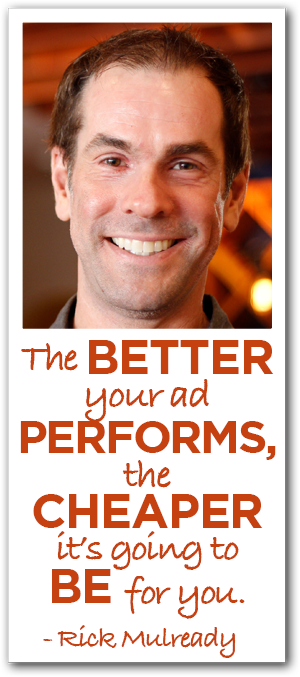 What role can Facebook play in your online marketing campaigns? Are Facebook ads really that important if you’re a small business with a small advertising budget? The answer is YES!
What role can Facebook play in your online marketing campaigns? Are Facebook ads really that important if you’re a small business with a small advertising budget? The answer is YES!